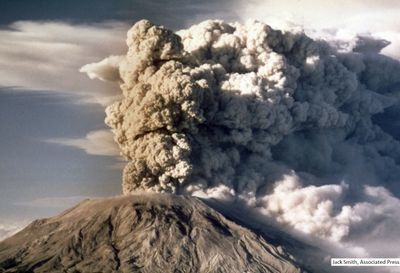Every year on May 18, we remember the eruption of Mount St. Helens in 1980. This year, we are commemorating the eruption by encouraging folks to visit the Science and Learning Center at Coldwater. Our partners from the Washington Emergency Management Division and U.S. Geological Survey (USGS) Cascades Volcano Observatory and other preparedness experts will be available to discuss the volcano from 10 am to 3 pm.
Unable to join us on May 18? Here are the other ways to participate in Volcano Awareness Month this May.
May 16, 2024, 11 am - 1 pm: A Reddit Ask-Me-Anything session. A free Reddit account is needed to participate but not to read the responses. Follow this account to be notified when the session is live.
May 22, 2024, 7 pm - 8:30 pm: Cascades Volcano Observatory Scientist-in-Charge Jon Major will talk about Lava, Mudflows, and Ash: Volcanoes in the Pacific Northwest at the Alberta Rose Theatre in Portland. Tickets are required.
The Science and Learning Center at Coldwater (SLC) is a hands-on education center located seven miles from Mount St. Helens crater and operated by the Mount St. Helens Institute (MSHI). The SLC offers spectacular views and immersion into the volcanic landscape in the heart of the blast zone. Mount St. Helens is one of the only places in the world where you can see firsthand the landscape recovering from disaster.

The hummocks, the remnants of the landslide during the 1980 eruption, near the Science and Learning Center invite visitors to see how the landscape created an opportunity for recovery. When the eruption in 1980 sent a giant debris landslide into the Toutle River valley, it took chunks of snow and ice. When the ice melted, the water seeped into the ground below, and the debris above settled into the space left by the melting ice. The undulating landscape from chunks of mountain and melted ice created perfect opportunities for micro-ecosystems to form, encouraging life to return to the landscape. We see the effects of this today in the variety of life found along the Hummocks trail - including thatch ants, beaver, and salamanders - that thrive in the unique landscape created just 44 years ago. Mount St. Helens is a site of continuous geologic change where landslides tear the volcano apart while lava flows and domes work to rebuild it.
The SLC is currently open every weekend. Beginning May 25, the US Forest Service will open it seven days a week. The SLC will be the main visitors center for the Mount St. Helens National Volcanic Monument, operated by the Forest Service due to the closure of the Johnston Ridge Observatory.
MSHI provides a guided Eruption Hike, a thrilling adventure that allows guests to see the changes in the terrain up close. This is not just a hike, it's a journey through time and nature. Visitors can hike along the verdant ponds among the huge hummocks deposited by the 1980 eruption before ascending Johnston Ridge to the Observatory for lunch.
On the trail, hikers will learn about the impact of the 1980 eruption on this once-forested and inhabited landscape and witness the ongoing ecological change. As folks amble through spectacular wildflower displays, watch for elk or mountain goats in the vast Pumice Plain below. The guided Eruption Hike is a unique opportunity to see nature in action.
To visit the Science and Learning Center at Coldwater, visit https://www.mshinstitute.org/learn/science-learning-center.html
To learn more about guided adventures or to sign up for our Eruption Hike, visit https://www.mshinstitute.org/explore/guided-adventures/